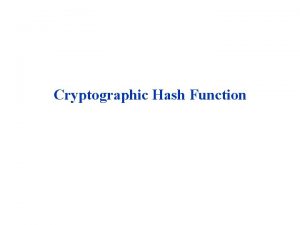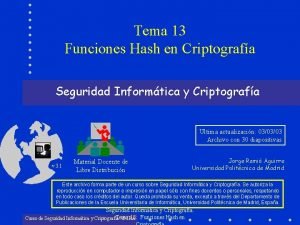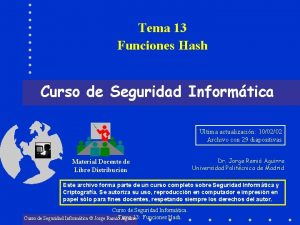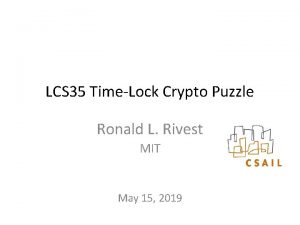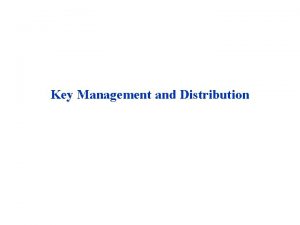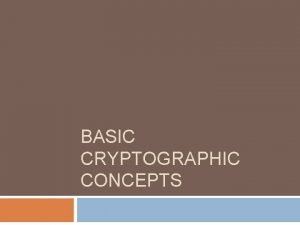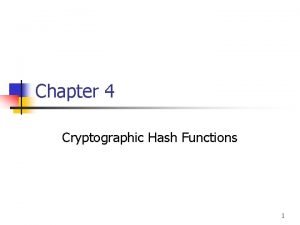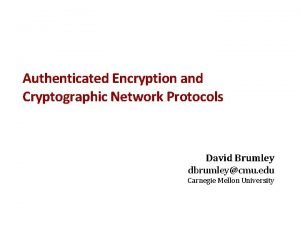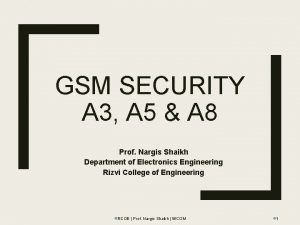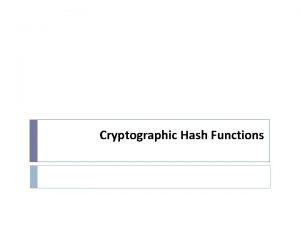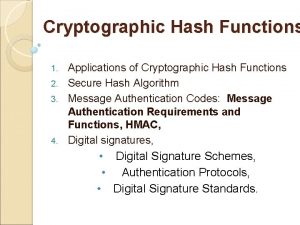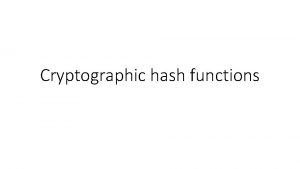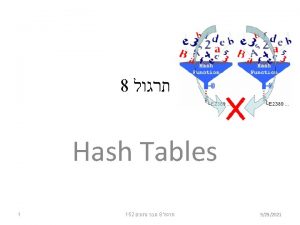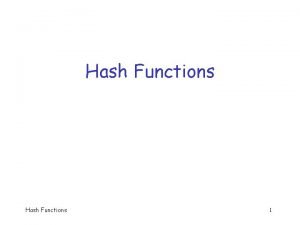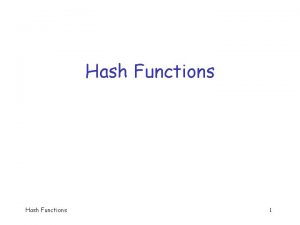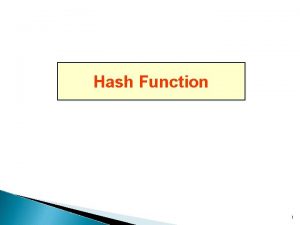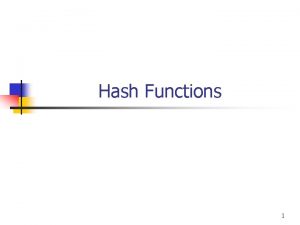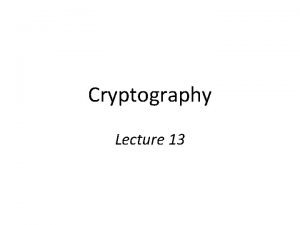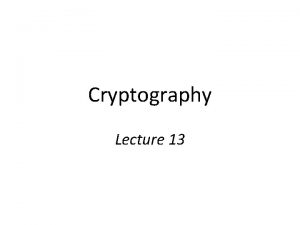Module2 Cryptographic Hash Definition A hash function is













- Slides: 13

Module-2

Cryptographic Hash • Definition: A hash function is a deterministic function that maps an input element from a larger (possibly infinite) set to an output element in a much smaller set. • The input element is mapped to a hash value. • For example, in a district-level database of residents of that district, an individual's record may be mapped to one of 26 hash buckets. • Each hash bucket is labelled by a distinct alphabet corresponding to the first alphabet of a person's name.


• A cryptographic hash function, h(x), maps a binary string of arbitrary length to a fixed length binary string. The properties of h are as follows: 1. One-way property. Given a hash value, y (belonging to the range of the hash function), it is computationally infeasible to find an input x such that b(x) = y 2. Weak collision resistance. Given an input value x 1, it is computationally infeasible to find another input value x 2 such that h(x 1) = h(x 2) 3. Strong collision resistance. It is computationally infeasible to find two input values x 1 and no x 2 such that h(x 1)=h(x 2) 4. Confusion + diffusion. If a single bit in the input string is flipped, then each bit of the hash value is flipped with probability roughly equal to 0. 5.


2. 2. 2 Attack Complexity • Weak Collision Resistance • Strong Collision Resistance

THE BIRTHDAY ANALOGY • Malloc does the following: • 1. He creates millions of documents, Fl, F 2, ………Fm, etc. that are, for all practical • purposes, "clones" of F. • 2. This is accomplished by leaving an extra space between two words, etc. • 3. If there are 300 words in F, there are 2300 ways in which extra spaces may be left • between words. • 4. He computes the hashes, h(F 1 ), h(F 2), . . . h(Fm) of each of these documents. • 5. He creates an innocuous document, D — one that most people would not hesitate to • sign. (For example, it could espouse an environmental cause relating to conservation • of forests. ) • 6. He creates millions of "clones" of D in the same way he cloned F above. • 7. Let D 1, D 2, . . . be the cloned documents of D. • 8. He computes the hashes, h(D 1), h(D 2), . . . h(Dm) of each of the cloned documents. • 9. Malloc asks Alka to sign the document D, and Alka obliges. • 10. Later Malloc accuses Alka of signing the fraudulent document • 11. the digital signature is obtained by encrypting the hash value of the document using • the private key of the signer. • 12. Thus, Alka's signature on Dj, is the same as that on Fi, . • 13. Hence, at a later point in time, Malloc can use Alka's signature on Dj), to claim that • she signed the fraudulent document, F. , .

2. 3 CONSTRUCTION • 2. 3. 1 Generic Cryptographic Hash



2. 4 APPLICATIONS AND PERFORMANCE • • • 2. 4. 1 Hash-based MAC MAC is used as a message integrity check as well as to provide message authentication. It makes use of a common shared secret, k, between two communicating parties. The hash-based MAC that we now introduce is an alternative to the CBC-MAC. The cryptographic hash applied on a message creates a digest or digital fingerprint of that message. Suppose that a sender and receiver share a secret, k. If the message and secret are concatenated and a hash taken on this string, then the hash value becomes a fingerprint of the combination of the message, m and the secret, k. MAC = h (m|| k) The MAC is much more than just a checksum on a message. It is computed by the sender, appended to the message, and sent across to the receiver.

• In the event of a match, the receiver concludes the following: • (a) The sender of the message is the same entity it shares the secret with — thus • the MAC provides source authentication. • (b) The message has not been corrupted or tampered with in transit — thus the • MAC provides verification of message integrity. Drawbacks: • An attacker might obtain one or more message—MAC pairs in an attempt to determine the MAC secret. • First, if the hash function is one-way, then it is not feasible for an attacker to deduce the input to the hash function that generated the MAC and thus recover the secret. • If the hash function is collision-resistant, then it is virtually impossible for an attacker to suitably modify a message so that the modified message and the original both map to the same MAC value.

HMAC 2. 4. 2 Digital Signatures
